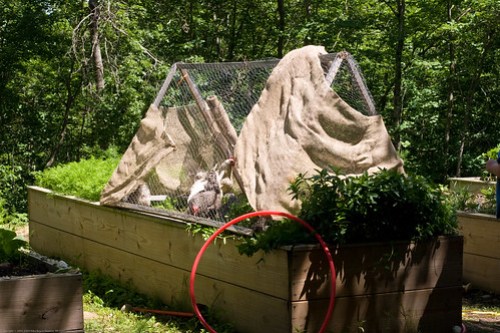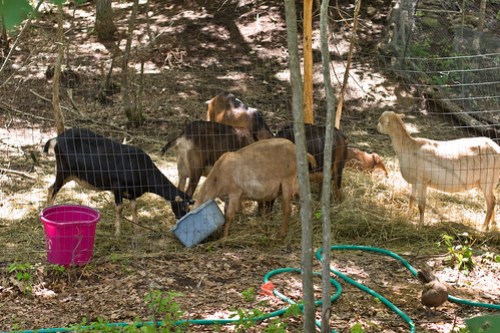
(Some of the contents of this post might be disturbing to the more gentle or delicate reader. I do not mean to offend you, please accept my apologies. I dont mind if you stop reading and visit other of my posts that are much less gory!)
Make no mistake, if you get goats, you will get your hands dirty, less sleep, more manure, lots of broken fences, some broken hearts, and some experience pretending like you actually know something about goat health and veterinarian practices.
If you are a long time reader, you will remember the excitement of this last early, snowy spring, when we had our kidding season. We lost one goat (RIP Wheatie, our sweet goat girl), gained lots of goat babies and some modicum of caprine midwifery experience.
I even got to reach into the back of a screaming goat momma, up to my upper forearm, to pull out what I was certain to be a dead goat to find it perfectly healthy and I didnt kill the momma either (was certain I would do that too). As I was holding that baby, feeling more alive myself although also a bit shocky, I re-learned something I always know as a scientist – I know little but in knowing that I know little I am open to learning a bit more. As I knelt there, holding a strong little buckling and watching the momma goat de-stress, I knew that I had no idea if she still had another kid inside. I palpated her tummy but it all felt like a round tummy and I had no objective concept of what another kid might feel like.
Our goat mentor arrived and kindly helped re-assure me that we had done well and that the momma had only one kid.
I have been trying to steel myself for the next kidding season since. We have been breeding the girls up in recent weeks so it seems we will go through that hell again!
But, of course, I always have something new to learn. One is that its not just kidding season that can bring medical emergencies. About a week ago last Saturday we noticed one of the 6 month old kids was acting odd, tilting her head, acting dizzy, eyes sort of vibrating around in their sockets, back and forth.
The followng images shows you a bit of what it was like. She essentially had no control over one side of her body because the bacteria were attacking her brain stem. The movements or the odd positions you see were involuntary and also very painful for us to watch.
This first shot shows the improvised enclosure we made for her.

Here are a few positions of note.



My first and relatively long lasting response was to feel panic, panic I KNEW was counter-productive but which was there anyways. Panic because we have no way of affording any vet care at all. Period.
I looked in our goat health books and realized how hard it is to do a differential diagnosis while in a panic and also while looking at these diseases for the first time. I googled her symptoms and was able to triangulate closer to the possibilities.
I finally settled on two diseases which are commonly co-diagnosed because they are so similar: Goat Polio (thiamine deficiency – easy to treat) and Listeriosis (HARD to treat and bad prognosis).
What is Listeriosis? Its a bacterial infection, run away infection of listeria. It occurs in goats, cows, all sorts of animals including we humans.
Wiki says this about this disease:
Listeriosis is a bacterial infection caused by a gram-positive, motile bacterium, Listeria monocytogenes. Listeriosis is relatively rare and occurs primarily in newborn infants, elderly patients, and patients who are immunocompromised.
The symptoms of listeriosis usually last 7-10 days. The most common symptoms are fever and muscle aches. Nausea and diarrhea are less common symptoms. If the infection spreads to the nervous system it can cause meningitis, an infection of the covering of the brain and spinal cord. Symptoms of meningitis are headache, stiff neck, confusion, loss of balance, and convulsions.
Listeriosis has a very low incidence in humans. However, pregnant women are much more likely than the rest of the population to contract it. Infected pregnant women may have only mild, flulike symptoms. However, infection in a pregnant woman can lead to early delivery, infection of the newborn, and death of the baby.
In veterinary medicine, listeriosis can be a quite common condition in some farm outbreaks. It can also be found in wild animals; see listeriosis in animals.
More specifically, in non-human animals:
Listeriosis is an infectious but not contagious disease caused by the bacterium Listeria monocytogenes, far more common in domestics animals (domestic mammals and poultry), especially ruminants, than in human beings. It can also occur in feral animals—among others, game animals—as well as in poultry and other birds.
The causative bacterium lives in the soil and in poorly made silage and is acquired by ingestion. It is not contagious; over the course of 30-year observation period of sheep disease in Morocco, the disease only appeared in the late 2000s when feeding bag-ensiled corn became common. Moreover, in Iceland, the disease is called “silage sickness”.
The disease is usually sporadic, but can occur as farm outbreaks in ruminants.
Three main forms are usually recognized throughout the affected species:
* encephalitis, the most common form in ruminants
* late abortion
* gastro-intestinal septicemia with liver damage, in monogastric species as well as in preruminant calves and lambs
Listeriosis in animals can rarely be cured with antibiotics (tetracyclines, chloramphenicol) when diagnosed early, in goats, for example, by treating upon first noticing the disease’s characteristic expression in the animal’s face,[4] but is generally fatal.
The Merck Vet Manual describes the symptoms as follows:
Initially, affected animals are anorectic, depressed, and disoriented. They may propel themselves into corners, lean against stationary objects, or circle toward the affected side. Facial paralysis with a drooping ear, deviated muzzle, flaccid lip, and lowered eyelid often develops on the affected side, as well as lack of a menace response and profuse, almost continuous, salivation; food material often becomes impacted in the cheek due to paralysis of the masticatory muscles. Terminally affected animals fall and, unable to rise, lie on the same side; involuntary running movements are common.
I called my goat mentor and she has had the great fortune of never dealing with this disease in her 20 years and 100s of goats (she has a great business – Shepherd’s Gate Dairy). She cautioned that the prognosis was poor if it was listeriosis. She suggested I call Tufts Vet.
I did a postdoc at Tufts Vet and have had animals vetted there so I know how massively expensive they are. I was profoundly fortunate to be able to talk, on the phone, for free, with a vet who was able to tell me some things about this disease.
The consensus was, put her down. I have grown an aversion to killing and I do not own a gun or injectable drugs to do the job so I chose to do the treatment and see what happened.
At that point I was less worried about the sick goat and MUCH more worried that my son was going to get it from the does in milk who might have it and be asymptomatic (we drink – drank – their milk raw). My son has seen enormous healing strides from a non-verbal autistic child to a verbal intelligent child who just started preschool today. He got almost a year of daily one-on-one ABA therapy and gallons upon gallons of raw goat milk with I think was instrumental in his progress.
Now, I was panicking that the raw milk was also going to kill him. Panic is an evil evil human emotion. Must remember to be more Vulcan next time.
I found this amazing resource on treating listeriosis at Onion Creek Ranch.
So 8 days ago we started injecting our little goat, Felicity, with 3.9 ccs of 300,000 IU Penicillin, subcutaneously, every 6 hours, 24 hours a day. She was almost paralyzed when we started. I pinched up her skin over her ribs and injected the milky white antibiotic into the gap between her lifted skin and the muscles and ribs just beneath.
Our schedule was this (rain, shine, wind, light, dark, cold, chilly, somewhat warm) 12 noon, 6 pm, 12 midnight, 6 am, rinse and repeat.
She was a trooper and continued to eat. My daughter was my vet tech this whole time. She forced water into the goat’s mouth the first few days but the goat has been eating and drinking on her own.

We have likely 2 more days, possibly more, of this schedule. She, against all the odds, is healing! She still seems to tilt her head so we need that to resolve. She is HATING her isolation and she gains strength every day.
You can see her here. She fears me now, thanks to the brutal injection schedule.



We have to be careful when we stop treatment with the antibiotics by treating her with probiotics to repopulate her rumen with beneficial bacteria.
Right now, she is one sick animal but I think she is going to make it.
Before this, I had never given an injection to anything but chicks, rabbits, and mice. Now I am quite a pro at it.
I would prefer to not have to do this ever again.
We love her now, have grown attached.
The rest of the herd seems perfectly fine.
Homesteading is all about the DIY worldview. You may gain some sense of mastery but its illusory! We are now battling a massive drop in milk production due to the seasonality of this breed and we STILL need to get things ready for our -20 F winter days.






























































































